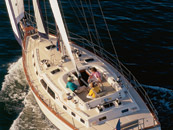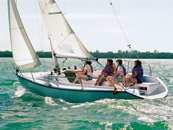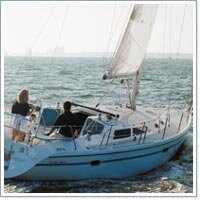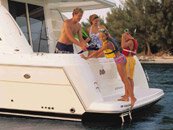By Stuart Walker
Lake sailing is more complex than sailing on the open sea, but more predictable. A lake, like any body of water enclosed by land, is subject to gradient winds, always offshore, and by thermal winds -- the lake breeze itself as well as winds generated by the surrounding terrain.
A lake is an oasis of calm in the surrounding land; a pool of cool marine air trapped above its surface protects it from the gradient winds and facilitates the development of thermal winds confined to the lake surface and its surroundings. Cold lakes can only expect a sailing wind on clear days in the presence of insolation (surface heating by the sun), and the winds that are then most likely are a morning offshore downslope wind, an afternoon onshore lake breeze, or an afternoon offshore expansion differential wind (created when the pressure levels above an elevated lake fail to rise as much as those above the surrounding heated lowlands). Then thermal turbulence (heated air rising and expanding and cooler air sinking above the near-shore heated land) brings the cool air on the upper mountain slopes down to the lake or brings the cool marine air onshore in a lake breeze and brings upper, higher velocity airflow in an overflowing gradient or expansion differential wind offshore onto the lake surface. If the only wind available is flowing offshore, expect it to be strongest, gustiest, and most veered near the windward shore.
In such a case there are two rules of thumb:
- In a cold, offshore wind with sunshine, take the tack that will get you to the windward shore as directly as possible and approach the weather mark on starboard.
- In a dying offshore wind, head for the windward shore where thermal turbulence will bring to the surface whatever flow persists.
If the sun is not shining, and thereâs no thermal liftoff ashore, or if the gradient airflow is considerably warmer than the lake, expect near-shore layering of warm gradient wind air over the cold lake air, a calm blanketed zone extending off the windward shore three-to-five times the height of the near-shore land, a modest air flow reaching the surface of the middle of the lake intermittently and in patches, and another calm zone extending up to nine times the height of the land off the leeward shore. In a warm offshore wind without sunshine, avoid all shores, particularly high windward and leeward shores.
Except on large lakes, an onshore breeze is a thermal wind--a lake breeze with the cold marine air flowing toward the insolated land, or an upslope wind with the marine air entrained in an along-the-slope flow from lower altitudes under higher pressure toward higher altitudes under lower pressure. Each wind facilitates the other, and theyâre usually co-existent.
The lake breeze depends on the insolation of the low-level, near-shore land and the upslope wind depends on the insolation of the peaks where lift-off is facilitated by the reduced ambient pressure. Lake breezes and upslope winds veer with increases in velocity in early afternoon (and back with decreases in late afternoon), extend from a calm zone in mid-lake and flow, accelerating and veering as they advance, toward whichever shore has a tributary extending inland or the highest near-lake mountain or the lowest, flattest, most readily insolated near-shore land.
Therefore, in lake breezes and upslope winds, avoid the center of the lake where there will always be the least amount of wind. On clear (or partially clear) days the thermal wind begins near midday a mile or so from shore, is strongest and most veered near shore, and is characterized by small oscillating shifts due to the intermittency of liftoff ashore. In late morning the developing flow, backing with distance to windward, produces a "fan effect." Boats leaving the starting line on starboard find that the farther they proceed offshore before tacking, the higher they can point on port. Â
Early in the development of these lake breezes, expect backing with distance sailed to windward; take starboard tack from the starting line offshore to the most lifted port tack close to the layline.
The likelihood of development and the strength of lake breezes and upslope winds are proportional to the ease of liftoff from the near-lake land (which is proportional to the lapse rate [the disparity between the temperature of the insolated land surface and the overlying air]) and to the coldness of the lake water and are greatly influenced by the direction and temperature of the gradient wind. Thus, lake breezesâcontrary to popular opinionâare more frequent in winter, when the water is cold and the overlying air is more likely to be cold and dry, more frequent with (or on the side of the lake with) an opposing, offshore gradient wind that is warmer than the marine air rather than an onshore gradient wind (because the offshore flow supplies the upper return flow for the lake breezeâs vertical circulation) and more frequent on cool, dry days rather than hot, humid ones. The initial movement of the cold marine air toward the shore increases in velocity as the surface temperature increases, but is only of moderate strengthâ5- to 8-knotsâuntil and unless the marine flow "crosses the shoreline."
When the cold marine air begins to flow over the hot land, it is producing a high lapse rate of its own, and accelerates at progressively increasing velocity (up to 15- to 20-knots) into the low pressure heat "sink" ahead.
In strengthening, established lake breezes, expect a velocity veer; take port tack initially, expecting additional veering. Sometimes a cold offshore gradient airflow may be brought to the surface by thermal turbulence along one side of the lake, but will be lifted by the onshore flow of the lake breeze on the other. Then both winds may persist in different parts of the lake.
In two winds simultaneously, seek as soon as possible to cross to and move upwind in the wind in which the weather mark lies. This means avoiding the center of the lake where neither wind will be strong. Never cross the lake twice.
In proportion to their coldness, expect all winds, but particularly cold airflows such as lake breezes and downslope winds, to be channeled by the elevated land along the lakeâs shores. The airflow will deviate toward the center of the lake as it approaches promontories along its sides and away from the center of the lake as it leaves them and will turn so as to flow parallel with the long axis of narrow lakes and their tributaries.
In cold offshore or onshore winds, expect channeling. Keep inside and nearer to the point than your competitors when rounding a promontory or a bend in a narrow lake so as to profit from the localized lift on the offshore tack. And if the lake is narrowing as you sail to windward, the wind is spreading outward along its sides. Keep to the middle and avoid the progressive near-shore lift on the inshore tack. If the lake is widening as you sail to windward, the wind is funneling inward along its sides. Go for the shore and the near-shore header on the inshore tack.
All near-shore advantages are comprised of one or both of two factorsâan acceleration of the airflow in a near-shore band (in cool offshore winds) and/or a heading shift on the tack headed most directly toward the shore (with channeling) that permits a boat to shorten its course by tacking to the lifted offshore tack.
Parallel-to-shore winds (gradient or lake breeze) provide both advantages. The segment of the wind flowing over water accelerates (relative to the overland segment) and; when the water is on the right of the flow, diverges from the slower overland segment. The result is both additional acceleration due to the divergence, which reduces pressure along its interface, and veering due to the acceleration. The result is a near-shore band of both stronger and veered air that seems to be flowing off the shore and two major advantages to the boat that immediately heads right and first enters and sails in that bandâincreased velocity and a lifted starboard tack. Because convergence and deceleration occur along the left hand shore, it must be avoided.
In parallel-to-shore winds, if the weather mark is to the right of the middle of the lake, tack immediately to port and head for the right shore. Tack to starboard after getting well into the near-shore band of veered air (when you believe the veer has ceased to increase) and keep in the band until you can easily lay the mark.
Â
Shared with Permission by Sailing World.



